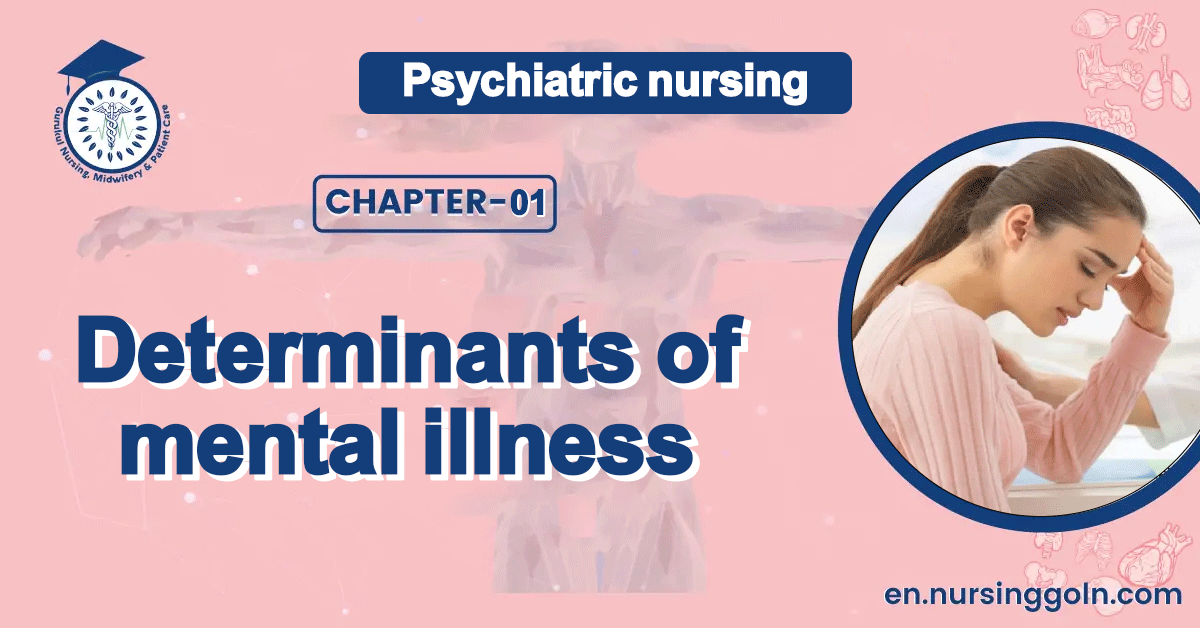Determinants of mental illness – This book covers the entire syllabus of “Psychiatric Nursing” prescribed by the Universities of Bangladesh- for Basic and diploma nursing students. We tried to accommodate the latest information and topics. This book is an examination-friendly setup according to the teachers’ lectures and examination questions.
At the end of the book previous university questions are given. We hope in touch with the book students’ knowledge will be upgraded and flourish. The unique way of presentation may make your reading of the book a pleasurable experience.

Determinants of mental illness
Warning signals of poor Mental Health:
✔ Worrying all the while.
✔ Inability to concentrate.
✔ Continually unhappy.
✔ Loses temper easily.
✔ Regular sleep disturbance,
✔ Incapacitating fluctuations of mood.
✔ Continual disliking of people’s company.
✔ Easily upset by disturbed daily routine.
✔ Having constant pain and aches without physical cause.
✔ Fear and panic without real cause.
✔ Feeling own decisions always right and other’s wrong.
[Ref: RKH/5/425)]
Or (Another Answer)
In Adults, Young Adults and Adolescents:
- Confused thinking
- Prolonged depression (sadness or irritability)
- Feelings of extreme highs and lows
- Excessive fears, worries and anxieties
- Social withdrawal
- Dramatic changes in eating or sleeping habits
- Strong feelings of anger
- Strange thoughts (delusions)
- Seeing or hearing things that aren’t there (hallucinations)
- Growing inability to cope with daily problems and activities
- Suicidal thoughts
- Numerous unexplained physical ailments
- Substance use
In Older Children and Pre-Adolescents:
- Substance use
- Inability to cope with problems and daily activities
- Changes in sleeping and/or eating habits
- Excessive complaints of physical ailments
- Changes in ability to manage responsibilities – at home and/or at school
- Defiance of authority, truancy, theft, and/or vandalism
- Intense fear
- Prolonged negative mood, often accompanied by poor appetite or thoughts of death
- Frequent outbursts of anger
In Younger Children:
- Changes in school performance
- Poor grades despite strong efforts
- Changes in sleeping and/or eating habits
- Excessive worry or anxiety (i.e. refusing to go to bed or school)
- Hyperactivity
- Persistent nightmares
- Persistent disobedience or aggression
- Frequent temper tantrums.

Causes of mental health problems
Causes of mental illness:
The causes of mental illness are multiple and complex. The causes can be grouped into three major areas –
1. Biological factors
➤ Genetic (Hereditary)
➤ Biochemical
➤ Brain damage
2. Psychological factors-Personality and temperament
➤ Early upbringing
➤ Conflicts
3. Social factors
➤ Loss
➤ Psychosocial stresses
➤ Sociocultural factors
➤ Adversity
➤ Poverty
➤ Migration
➤ Unemployment
➤ Urbanization.
[Ref: S Nambi/24/41]
Factors contributing to mental illness
Factors contributing to mental illness:
1. Physical factors:
- Cerebral tumors
- Drug intoxication
2. Physiological factors:
- Pregnancy
- Child birth
- Puberty
- Menopause
- Fever
- Involution
3. Social factors:
- Earthquake.
- Flood.
- Epidemic attack of contagious disease.
- Political upheavals and social crisis.
- Occupational and financial difficulties
4. Psychological factors:
- Strained interpersonal relationship.
- Family and marital disharmony.
- Sexual mal-adjustments.
- Death of a loved one
[Ref: K. Lalitha/1/26-271]
Or,
Risk factors of mental illness:
Certain factors may increase your risk of developing mental health problems, including:
- Having a blood relative, such as a parent or sibling, with a mental illness
- Stressful life situations, such as financial problems, a loved one’s death or a divorce
- An ongoing (chronic) medical condition, such as diabetes
- Brain damage as a result of a serious injury (traumatic brain injury), such as a violent blow to the head
- Traumatic experiences, such as military combat or being assaulted
- Use of alcohol or recreational drugs
- Being abused or neglected as a child
- Having few friends or few healthy relationships.
- A previous mental illness
Mental illness is common. About 1 in 5 adults has a mental illness in any given year. Mental illness can begin at any age, from childhood through later adult years, but most begin earlier in life.

Preventive measures of mental illness
Prevention of mental illness:
The prevention of mental illness is based on public health principles and has been divided into:
1. Primary prevention.
2. Secondary prevention.
3. Tertiary prevention.
The aim of prevention is to decrease, the onset (incidence), duration (prevalence) and residual disability of mental disorder.

A. Primary Prevention:
Primary prevention involves the promotion of general mental health and protection against the occurrence of specific diseases. Primary prevention aims to prevent the onset of a disease or disorder, thereby reducing the incidence (number of new cases occurring in a specific period of time).
Measures for primary prevention include:
1. Elimination of etiological agents.
2. Reducing risk factors.
3. Enhancing host resistance or interfering with disease transmission.
4. Reducing stress factors
5. Counseling
➤ Student’s counseling
➤ Marriage counseling
➤ Sex counseling
➤ Genetic counseling.
6. Special centers
➤ Child guidance center
➤ Crisis intervention center
➤ Geriatric center
7. Mental health education
➤ The message of prevention, early recognition and effective treatment should reach them.
➤ Repeated efforts to give correct information will lead to a positive change and the misconceptions about mental illnesses removed.
B. Secondary Prevention:
Early identification and effective treatment of an illness or disorder with the goal of reducing the prevalence (total number of existing cases in a year) is the aim of secondary prevention.
The essential components of secondary prevention are
➤ Population screening
➤ Crisis intervention services
➤ Mental health promotion
C. Tertiary prevention:
This aims to reduce the prevalence of residual defect or disability due to illness or disorder. Tertiary prevention involves rehabilitation after defect and disability have been fixed. Human behavior can be changed, by gradual shaping, into completely new responses.
This can be achieved by behavior therapy methods like token economy. Modem tertiary prevention of mental illness or rehabilitation of the seriously disabled mentally ill persons is one of the great success stories of psychiatry.
(Ref: S Nambi/2/173-1741)
Read more:
